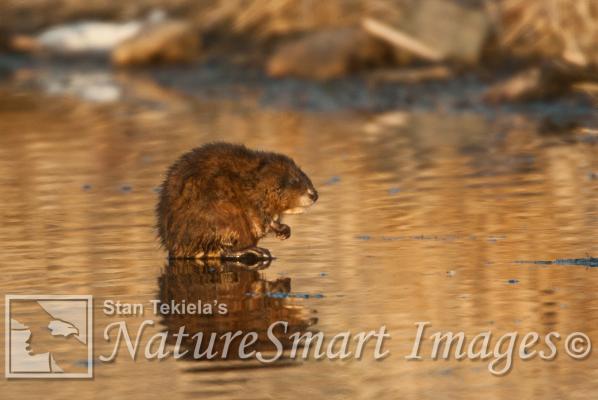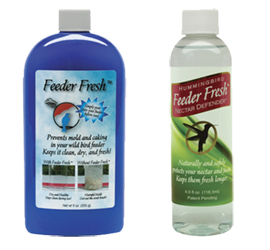View all of the titles in the
NatureSmart Bookstore

by Stan Tekiela
© NatureSmart
December 26, 2022
I am fascinated by a small fuzzy critter that is found just about anywhere there might be a spot of water in the United States and Canada. Not to mention, it has mastered a wide range of habitats and climates. Although it was introduced, it is also found throughout Europe and in parts of Asia and even South America. It is a common critter, but I am not sure you are seeing this critter very often or perhaps even know what it is.
So, what is the small fuzzy critter, it is the Muskrat (Ondatra zibethicus). Ya, that’s right, the Muskrat. Before you wig out and become hyper critical of this semiaquatic rodent, hear me out. The Muskrat is a small critter allowing it to elude being seen much of the time. It is only 2-4 pounds and around 8 to 10 inches in length not counting the long thin tail which is another 8 or so inches long. In addition, it comes out at dawn and dusk or in the middle of the day if it is cloudy.
I mentioned they are fuzzy because they are covered with thick short brown fur that was often used by people to make hats and gloves. Their fur is waterproof and is made up of two layers. The underlying fur traps air which keeps them warm and dry. The longer outer fur protects the underlying fur and gives them their color.
They have a long naked tail that is covered in scales rather than fur. The tail is slightly flattened from top to bottom (laterally) and is used to help with propulsion when swimming however it is their back legs with oversized webbed feet which act like paddles for their main power to swim. Speaking of water, the Muskrat can stay underwater for up to 15 minutes before needing to surface to take a breath.
What I find cool about these critters is that they live in family units consisting of a male and female which are a mated pair along with their young. They live in a lodge which they construct out of vegetative plant material such as cattails and bullrush. The lodge can be upwards of three to four feet tall and has an underwater entrance. However, many muskrats that live in habitat that lack cattails they often burrow a chamber into the lake or riverbank where they take shelter. This is the case where I live. The lake levels are way down due to a drought and the entrance to shoreline den is now high and dry. The muskrats did their best to maintain a channel in the mud so they could swim up to their den but with the ongoing drought it is now a 20-foot walk to get to their den entrance. One more example of their ability to adapt.
Muskrats are unique and they don’t have any similar relatives. Because of this they have been placed in a Genus all by themselves. Don’t let the common name “rat” confuse you, they are not related to rats and contrary to what some people say they are not mini beavers, because they are not closely related to beavers either. Their closes living relatives are the voles and lemmings, which are much smaller and most are not aquatic.
The common name comes from the “musky” odor, which it uses to mark its territory and its long naked tail which looks like a rat’s tail. In the springtime Muskrats will actually fight to keep or take a territory from other Muskrats. These fights can lead to death for the looser.
Territories are usually in shallow ponds and lakes. They like ponds with lots of cattails and other aquatic vegetation which is their main food source. However, they eat more than plants. In fact, they are omnivores and will also eat meat if an opportunity presents itself. They eat about one-third of their own body weight daily. They usually gather and eat from a small home range or territory of only an acre or two in size.
Muskrats are prolific breeders. Females can give birth to three or four litters of young, called kits, each year. Each litter can have anywhere from three to six young. The babies are full grown by six weeks of age and often stay with the family. They will build several more lodges nearby where the young members of the family will move in and start their own family.
I see these little critters when I go for a walk in the evening. When they see me approaching, they dive and usually don’t come back up where I can see them. But I enjoy catching a glimpse of them and I hope you will also. Until next time…
Stan Tekiela is an author / naturalist and wildlife photographer who travels the world to study and capture images of wildlife. He can be followed at Instagram.com, facebook.com and twitter.com. He can be contacted via his web page at www.naturesmart.com.
The nationally syndicated NatureSmart Column appears in over 25 cities spanning 7 states: Minnesota, Wisconsin, Michigan, Illinois, Ohio, New York and Pennsylvania. It is a bi-weekly column circulated to over 750,000 readers.
Wolves
Just the day before, a pack of wolves known as the Wapiti, had found a large bull bison that was weak and injured. Based on its size, this big boy was near the end of its lifespan and the winter weather was taking its toll. For a full day the wolves tried to approach the bison but when the bison...
Moose
It was one of those dark and cloudy winter days in Yellowstone National Park where the clouds are so heavy and low, you feel like you can reach up and touch the cloudy sky. A light wind helped to blow the falling snow with occasional gusts of wind causing swirls of fluffy white snow...
American Badger
It’s funny, I believe the average person knows more about the Honey Badger (Mellivora capensis), a critter of Africa and Southwest Asia than they do about the badger in our own backyard, the American Badger (Taxidea taxus). Social media has a lot to do with the Honey Badger phenomena and...
Backyard Bird Feeding
Winter bird feeding is one of the most common / popular hobbies in America. It is estimated that nearly 60 million Americans feed birds in their yards in winter or summer. That is about 40 percent of all American’s make backyard bird feeding part of their everyday activities. It’s...
Each year, during June and July, Stan Tekiela offers two world-class wildlife photography tours. Here's your chance to learn some tricks of the trade from a top professional.
View all of the titles in the
NatureSmart Bookstore
Check out Stan's latest photos at
NatureSmart Wildlife Images
Do you have any interesting wildlife in your backyard? Any nesting birds, deer, turkeys, reptiles, amphibians, or other unique wildlife? Or maybe a fox or coyote den?
If so, contact Stan at stan@naturesmart.com with your backyard wildlife. If he can get a good photo of the subject, he will send you a print of the photo to hang on your wall.
Order Prints and posters of Stan's photos at
» Prints & Posters
Hear Stan on radio stations all across the Midwest.
» More Info

When he's out in the field, Stan relies on his Vortex Razor binoculars and Vortex Razor spotting scope to help find the subjects for his award winning wildlife photography.

For thirty years, professional wildlife photographer Stan Tekiela has counted on Hunt's Photo and Video to provide him with professional photography equipment.
From tripods to camera bodies and lenses, Hunt's has been Stan's place for everything that he needs. Personal service and prompt shipping means Stan can count on Hunt's to support his professional wildlife photography career.


Professional Wildlife Photographer Stan Tekiela always uses Feeder Fresh in his seed feeders to help keep the feeders and food dry, clean and mold free.
He also uses Feeder Fresh Nectar Defender in all of his hummingbird feeders. It safely keeps nectar fresh longer.